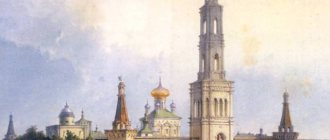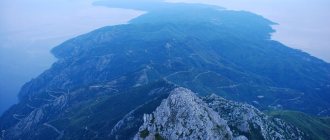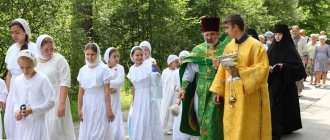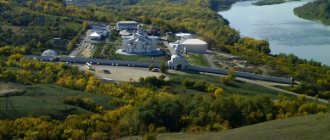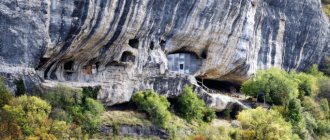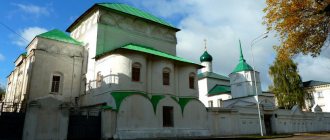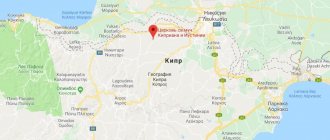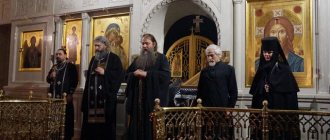Mir
Greece periphery Thessaly Monastery of the Great Lavra (Athos) Map is loading...
{"format":"leaflet","minzoom":false,"maxzoom":false,"limit":50,"offset":0,"link":"all","sort":[""], "order":[],"headers":"show","mainlabel":"","intro":"","outro":"","searchlabel":"\u2026 \u0441\u043b\u0435\ u0434\u0443\u044e\u0449\u0438\u0435 \u0440\u0435\u0437\u0443\u043b\u044c\u0442\u0430\u0442\u044b","default":"","import-annotation":false,"width ":"auto","height":"350px","centre":{"text":"","title":"""link":"""lat":40.171743399999996881888364441692829132080078125,"lon": 24.388512899999998495559339062310755252838134765625,"icon":""},"title":"","label":"","icon":"","lines":[],"polygons":[],"circles":[ ],"rectangles":[],"copycoords":false,"static":false,"zoom":8,"defzoom":14,"layers":["OpenStreetMap"],"image layers":[] ,"overlays":[],"resizable":false,"fullscreen":true,"scrollwheelzoom":true,"cluster":false,"clustermaxzoom":9,"clusterzoomonclick":true,"clustermaxradius":80, "clusterspiderfy":true,"geojson":"","clicktarget":"","showtitle":true,"hidenamespace":false,"template":"","userparam":"","activeicon": "","pagelabel":false,"ajaxcoordproperty":"","ajaxquery":"","locations":[{"text":"\u003Cb\u003E\u003Ca href=\"/palomnik/%D0% 9C%D0%BE%D0%BD%D0%B0%D1%81%D1%82%D1%8B%D1%80%D1%8C_%D0%92%D0%B5%D0%BB%D0%B8% D0%BA%D0%B0%D1%8F_%D0%9B%D0%B0%D0%B2%D1%80%D0%B0_(%D0%90%D1%84%D0%BE%D0%BD)\ » title=\»\u041c\u043e\u043d\u0430\u0441\u0442\u044b\u0440\u044c \u0412\u0435\u043b\u0438\u043a\u0430\u044f \u041b\u0430\u0432\u 0440\u0430 (\u0410 \u0444\u043e\u043d)\»\u003E\u041c\u043e\u043d\u0430\u0441\u0442\u044b\u0440\u044c \u0412\u0435\u043b\u0438\u043a\u0430\u044 f \u041b\u0430\u0432\ u0440\u0430 (\u0410\u0444\u043e\u043d)\u003C/a\u003E\u003C/b\u003E\u003Chr /\u003E\u003Ca href=\"/palomnik/%D0%A1%D0%B2%D0% BE%D0%B9%D1%81%D1%82%D0%B2%D0%BE:%D0%90%D0%BD%D0%BD%D0%BE%D1%82%D0%B0%D1%86 %D0%B8%D1%8F\" title=\"\u0421\u0432\u043e\u0439\u0441\u0442\u0432\u043e:\u0410\u043d\u043d\u043e\u0442\u0430\u0446\u0438\u044f\ »\u003E\u0410\u043d\u043d\u043e\u0442\u0430\u0446\u0438\u044f\u003C/a\u003E: »'\u041b\u0430\u0432\u0440\u0430 c\u0432\u044f\ u0442\u043e\ u0433\u043e \u0410\u0444\u0430\u043d\u0430\u0441\u0438\u044f"' \u0438\u043b\u0438 »'\u0412\u0435\u043b\u0438\u043a\u0430\u04 4f\u041b\u0430\u0432\ u0440\u0430"' \u2014 \u043f\u0435\u0440\u0432\u0435\u043d\u0441\u0442\u0432\u0443\u044e\u0449\u0438\u0439 \u043c\u043e\u043d \u0430\u0441\u0442\u044b\ u0440\u044c \u043d\u0430 \u0421\u0432\u044f\u0442\u043e\u0439 \u0413\u043e\u0440\u0435 \u0410\u0444\u043e\u043d; "title": "\u041c\u043e\ u043d\u0430\u0441\u0442\u044b\u0440\u044c \u0412\u0435\u043b\u0438\u043a\u0430\u044f \u041b\u0430\u0432\u0440\u0430 (\u0410\u 0444\u043e\u043d)",» link":"","lat":40.171743399999996881888364441692829132080078125,"lon":24.388512899999998495559339062310755252838134765625,"icon":""}]" imageLayers":[]}
40.27819; 24.217071
Greece, periphery of Thessaly, autonomous monastic state of the Holy Mountain
periphery Thessaly
Greece
Lavra of St. Athanasius
or
the Great Lavra
- the leading monastery on Holy Mount Athos; Founding time: 10th century. It is located on a small plateau in the southeast of the peninsula, half an hour’s walk from the sea. Patronal feast day: July 5 (18), St. Athanasius of Athos.
History[edit]
Lavra of St. Athanasius (Greek: Ιερά Μονή Μεγίστης Λαύρας.) - is located on a small plateau in the southeast of the peninsula near the sea. The monastery was founded in the 10th century by St. Athanasius, the most revered saint of Athonite. The architectural ensemble of the monastery was built with donations from the Byzantine emperors Nikephoros Phocas, Basil II and John Tzimisces. The Lavra also contains contributions from the last Russian emperor, St. Martyr Nicholas II. The Lavra's possessions are extensive - the entire southern tip of the Holy Mountain, the monasteries of St. Anna and Predtechensky (Romanian), Kavsokalyvia, Karulya, the center of these possessions is the very top of Mount Athos.
Times of growth alternated in the life of the Lavra with periods of decline. The number of monks ranged from six to seven hundred. Many patriarchs (27) and bishops (145) labored in the monastery. Many of them, out of their great humility, became simple novices in the monastery. Patriarch Anthimus of Constantinople, who arrived at the Lavra in 1623, found only six monks and large debts. Thanks to his efforts, the monastery not only survived difficulties, but also embarked on the path of new prosperity. Another Patriarch Dionysius III also contributed greatly to the revival of the monastery. He lived in the Lavra for 36 years and supervised the extensive construction and repair of monastery buildings.
The Lavra has never suffered from fires. This is due to the special promise given by the Mother of God to the Monk Athanasius of Athos.
During the difficult years of Turkish rule, the Great Lavra became a special monastery. The restoration of the ancient communal structure, commanded by its founder, took place in 1980 and opened a new page in the life of the monastery. At the moment of the solemn event from the grave of St. Athanasius of Athos received an amazing fragrance. Now there are relatively few monks in the Lavra. As a result, life in a large monastery is especially difficult - the fathers need to fulfill many obediences, and in addition, receive pilgrims, of whom there are always especially many in the Lavra. One must always remember this and enter into the difficult position of monks, who are not always able to give visitors a lot of time, warmth and attention.
Not far from the Lavra there is a small church in honor of St. unmercenary Cosmas and Damian, founded by St. Athanasius, at the direction of the Mother of God Herself, to get rid of the machinations of the devil, who tried to prevent the saint from building a monastery.
The Lavra Cathedral of the Annunciation of the Blessed Virgin Mary was founded by the Monk Athanasius in 963, and painted in the 16th century by the famous isographer Theophan of Crete, one of the greatest painters in the history of world art. The Lavra also preserved paintings by another outstanding master, Emanuel Panselinos (presumably the teacher of Theophanes). The temple, which became the prototype of a special “Athos style,” was built in such a way as to best meet the needs and liturgical features of the Svyatogorsk Rule. The cathedral has two chapels: St. Nicholas and the Forty Martyrs. In the latter there is a reliquary with the honest relics of St. Athanasius and a wonderful 12th century icon of the Savior. Also in the paraklis are the oldest candlesticks on the Holy Mountain. They date back to the 10th century.
In total, there are fifteen paraklises on the territory of the monastery and nineteen more outside it. The pilgrim should visit the sites of the exploits of St. Athanasius and St. Gregory Palamas, as well as the paraklis in honor of the Holy Unmercenaries, erected on the site of a pagan temple. Due to the fact that at night the demons destroyed all the buildings erected during the day, the Monk Athanasius, by divine inspiration, built the chapel within one day and upon completion of the construction immediately celebrated the Divine Liturgy in it. The demonic warfare stopped after that.
Between the cathedral and the refectory there is a unique monolithic phial of the 11th century and a thousand-year-old cypress planted by the Monk Athanasius himself. Nearby there is another tree, which was planted by his disciple Reverend Euthymius, the founder of the Iversky Monastery. In 1821, a Turkish military commander hanged three monks on them for preventing the removal of a vial, which he wanted to present as a gift to the Sultan. The refectory of the Lavra has the shape of a cross and is painted by isographers of the Cretan school. This is one of the most significant monuments on the Holy Mountain, largely preserving the appearance of the refectory built by the Monk Athanasius himself. Twenty-four marble tables apparently came to the monastery from Constantinople. The refectory was painted by Theophan of Crete. In addition to images of Saints, there are frescoes with portraits of Greek philosophers: Pythagoras, Socrates, Aristotle, Plato, Thales, Plutarch. Also interesting is the fresco in which the Mother of God drives away the pagan goddess Artemis, whose sanctuary previously existed on the site where the Lavra was built.
The construction of the Lavra Arsana began with the direct participation of St. Athanasius. In the 12th century, the famous five-story defensive tower was built. The path from the pier to the monastery takes about half an hour and runs through a dense forest.
More than fifty Saints labored in the Lavra and in the monasteries and cells subordinate to it. Among them are John Koukouzelis, St. Gregory Palamas and his comrade-in-arms, Patriarch Philotheus Kokkin.
The Lavra sacristy contains the gospel, crown and robes of Emperor Nicephorus Phocas, a unique Russian forty-kilogram gospel and many sacred vessels.
The area around the Lavra during the founding of the monastery was infested with snakes. Emperor Nicephorus, wanting to help the Monk Athanasius, sent him a gift of the tongue of an asp (a very poisonous snake) in a special case (also kept in the sacristy). This tongue, immersed in water, gives it antidote properties against snake venom.
The Lavra Library is considered the largest on the Holy Mountain - it houses 2050 manuscripts and more than 30 thousand printed books.
The main panigir of the Lavra is celebrated with special solemnity - the day of remembrance of St. Athanasius of Afonsky (July 5/18). This holiday attracts perhaps the largest number of pilgrims. The service sometimes lasts more than fifteen hours without interruption.
According to monastic tradition, the Mother of God herself commanded the monks to establish the main holiday of the Lavra on the day of memory of the Monk Athanasius. Previously, the panigir took place on the Annunciation; in honor of this holiday, the main cathedral of the monastery was consecrated. In 1425, on the day of this holiday, the Most Pure One appeared to the abbot and ordered to henceforth celebrate with special solemnity the day of memory of the saint, who had invested so much effort in his monastery.
Story
The monastery was founded back in Roman times in 344 by the Patriarch of Alexandria, Saint Athanasius the Great. According to legend, in those years an epidemic raged in this territory. Saint Athanasius settled in a cave that had once been a Thracian sanctuary with a consecrated spring. He preached Christianity to the local residents and said that if they built a church here, God would deliver them from the disease. When the Orthodox church was erected, the prediction came true. Over its almost seventeen-century history, the church and monastery were repeatedly destroyed and rebuilt.
In the 70s of the last century, on the initiative of the Ministry of Culture, a new monastery building was built. In terms of its scale, it is now one of the largest in Bulgaria. The monastery complex also includes a church, restored in 1961, and a fasting cave (the former home of St. Athanasius).
Shrines[edit]
In the Cathedral of the Forty Martyrs there is a shrine with the honest relics of St. Athanasius and a wonderful 12th century icon of the Savior. Among the many shrines, the monastery also houses the cross and staff of St. Athanasius (located in the Saint’s cell), miraculous icons of the Mother of God “Ekonomissa” (written in memory of the appearance of the Mother of God to the founder of the Lavra
, who promised to become the “economist” of the monastery. Since then, the Lavra has not elected a steward) and the “Kukuzelis”, located in the Vvedensky paraklis (arrived at the Lavra miraculously), as well as parts of the Life-giving Cross of the Lord in precious frames (a gift from Emperor Nikephoros Phocas), the honorable head of St. John Chrysostom, particles of the relics of St. App. Luke, Andrew, Barnabas, Titus, Prochorus, First Hour. archdeacon Stefan, equal to Apostles Constantine and Helena, St. Michael, Bishop of Sinada (due to his special intercession and repeated assistance to the Lavra, this Saint is considered the second patron of the monastery), St. Ignatius the God-Bearer and John the Merciful, martyr. Panteleimon, martyr. Artemia and Mercury, sschmchch. Ermolai, Antipas and Gregory, bishop, martyr. and Spanish Stefan Novy, mchch. Kirik, Nikita, Anikita, Akindin and Mina, mts. Iulites, St. Basil the Great, St. Jacob of Persian, Rev. Daniel the Stylite, Pachomius, Phocas, Ephraim the Syrian, Theodore the Studite, Eustratius, Luke of Greece, Nile the Myrrh-Streaming and John Kukuzel, Sampson the Host and Theodore the Sanctified, St. Procopius, St. bessrr. Cosmas and Damian, VMC. Marina, prmts. Fekly, mcc. Pelagia, Paraskeva and Minodora and other saints.
Creation of a monastic monastery
In 1997, in the town of Kadoma, the women's Kadoma Holy Mercy Monastery of the Mother of God began to be restored. Its existence has been known since 1793. It all started with the fact that several girls from merchant and bourgeois families decided to become nuns and live according to church rules. To do this, they turned to the Ryazan Epiphany Monastery to Abbess Evgenia, so that she could find them a wise mentor. After a short time, the abbess sent them the psalm-reader’s daughter, Ekaterina Gorskaya, who had good spiritual and monastic experience. She was able to establish monastic life in the newly formed community according to the rules of the Sarov monastery, which the Sarov elders immediately began to care for. There is even a legend that the Monk Seraphim himself once visited their monastery.
Thanks to well-coordinated and skillful leadership and unanimity among the nuns, the community began to gradually develop. First, land and some buildings were donated to her, then real construction began. In 1857, a summer church was built in honor of the icon of the Mother of God, called “Merciful,” then the construction of a second church and other buildings began.
Photo[edit]
- Great Lavra
- Great Lavra
- Great Lavra. Veneration of the icon of the Mother of God under a canopy
- Great Lavra. Monastery temple
- Great Lavra. Monastery temple
- Great Lavra. Monastery temple
- Great Lavra. At the tomb with the relics of St. Afanasy of Afonsky
- Great Lavra. Cypress, which was planted by St. Afanasy
- In the Great Lavra
- In the Great Lavra
- In the Great Lavra
- Great Lavra. Water Mill
(*) photo author: prot. Konstantin Parkhomenko
Devastation
On November 25, 1868, the community received the status of a monastery, at which a church school and an orphanage for orphan girls were formed. Before the revolution, the monastery numbered 365 nuns, but in 1917 it was destroyed, the settlers were dispersed, the property was nationalized, and all church utensils and icons were burned.
Only in our days, by the grace of God and the labors of people, the monastery began to be rebuilt again. But the most important thing was that in Cyprus, in the Kykkos monastery, the icon of the Mother of God “Merciful” was again painted especially for the Kadoma monastery. On Ryazan soil this event was greeted with great joy and celebrated with great celebration.
Information for pilgrims[edit]
Tel.: +(30-23770) 23754, 23785, 22586, 23760.
You can continue your journey from the Great Lavra either by boat, which runs along the north-eastern shore of the Holy Mountain, or by taxi minibus going to Karei (with easy access to the Caracal and Iviron monasteries). However, keep in mind that the northeast of the Athos Peninsula does not face the quiet Singitsky Gulf, but the stormy Aegean Sea, so the boat does not sail here every day, but only when there is no swell. The walk on foot (18 km to the nearest Karakal, 28 km to Iviron) will take a lot of time and effort. The minibus departs from the Lavra every day at seven in the morning, but you must register as a passenger the day before. On the way, the driver will probably make a short stop near the holy spring of St. Athanasius, who killed during the appearance of the Mother of God to him.
The monasteries of Caracal and Philotheus stand somewhat off the beaten path of pilgrimage, however, we recommend that you visit them. The brethren of these monasteries are very hospitable, in addition, each of the monasteries has its own unique flavor.
Chirpan Monastery of St. Athanasius the Great
Mir Bulgaria Stara Zagora region Chirpan Monastery of St. Athanasius the Great
Monastery of St. Athanasius the Great
, also known as
the Chirpan Orthodox Women's Monastery
, is located in Southern Bulgaria near the village of Zlatna Livada and 15 km from the town of Chirpan. The monastery stands in a picturesque place on the right bank of the Stara River. It is the oldest in Europe. This is a unique architectural monument and one of the cultural and historical attractions of Bulgaria.
Joining the Church
When her son was 13 years old, she took him to the temple in Savvatma, then Aunt Mariamne began to introduce Anatoly to the church and introduced him to the elder - Father Jacob, who had one eye. One day, the Soviet authorities sent him into exile, but the guards, seeing the weak old man, sent him home. The future father Afanasy confessed and took communion with him for the first time, but told the priest that he would never drink vodka and wine. The elder was surprised by these words and added that perfect people can drink vodka, but imperfect people cannot drink a drop of it.
A little earlier, due to his thirst for knowledge of God, Anatoly almost ended up with annoying Baptists. However, God saved him, and he began going to the Orthodox Church of St. Nicholas. First, Father Vasily (Romanov) served in this church, then Father Vladimir (Pravolyubov), and then the famous seer Father John (Krestyankin).
They all became his spiritual mentors. While still in the world, he got married and mastered the profession of 2nd mate on a ship. But then he left this profession to become a priest.
